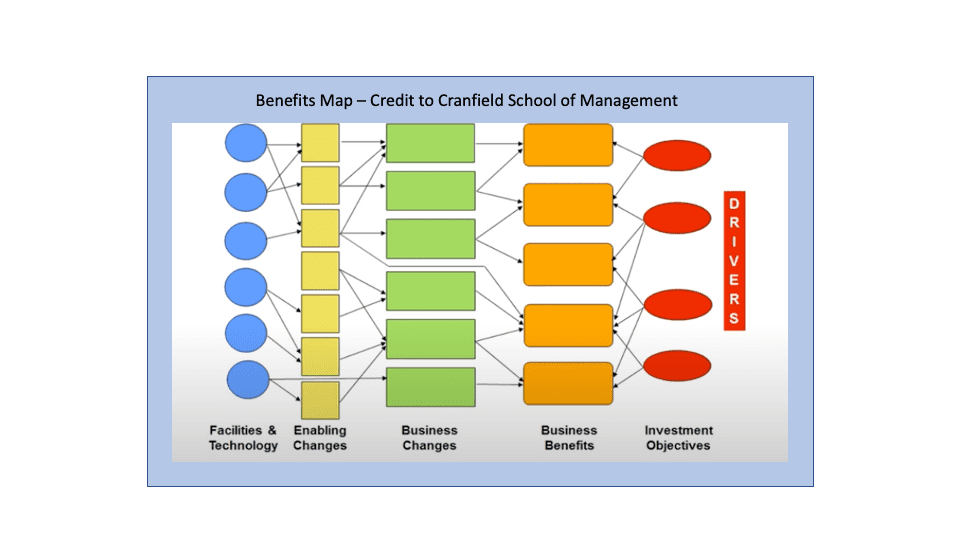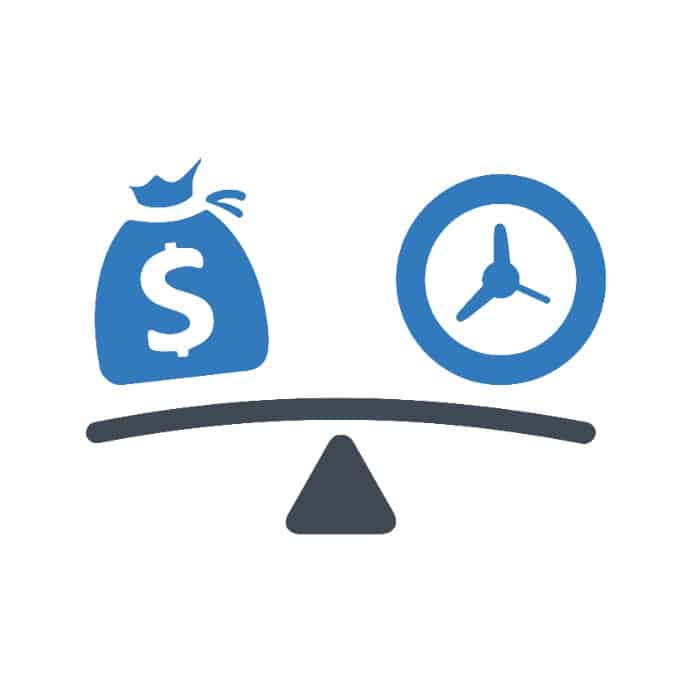Failing to define project goals clearly is a common issue – improperly set goals can lead to different expectations of the project by various stakeholders, time wasted on unimportant matters, or difficulty in understanding the purpose of the project in the first place.
To avoid all this, there should be a clear connection between the project activities and the business benefits they can bring. It’s not rare that everyone involved in the development process is focused solely on the product delivery without paying much attention to the actual benefits it may bring both to the organisation and the customers.
So, illustrating how the activities will result in benefits in a way that everyone will understand may very well be the key to better decision-making and to the success of the whole project. This is where the benefits map steps in as the best way to address these concerns by providing an easy-to-understand visual representation of connections between the overall corporate objectives, activities, and benefits.
Table of Contents
What is Benefits Map?
Benefits map is a technique of visual representation the links between overall business goals and project deliverables. It serves to show what the true value and benefits of a certain project really are. By taking project goals and depicting them in a visual manner, a benefits map makes those goals easy to understand and simple to track as the project progresses.
A properly designed benefits map will act as the GPS of the projects, guiding you through the development process and plotting the necessary steps for the journey to reach its desired destinations. It can provide real-time feedback to keep everyone moving in the right direction and working towards a common goal.
Ideally, a benefits map should be designed before the project has even started. Waiting until the process has already started will likely diminish its value and ability to provide guidance for all stakeholders involved. A timely created benefits map can give early warnings if there’s a threat to benefits realisation and provide development teams with an opportunity to address those issues and keep the project on track.
The process of benefits mapping itself communicates to the organisation what key benefits are expected to be achieved in a particular project. Through the mapping process, these benefits can be discussed and adjusted so they best reflect the organisational strategic goals. Once the benefits map is defined, it should demonstrate how the project results will lead to those benefits and what activities and procedures should be undertaken for the benefits to be realised
Simply put, benefits mapping should provide an organisation with an answer to why a certain program or project should be implemented. As the success of the project will be, in part, measured by the delivered benefits, the benefits map should indicate whether a project is worth undertaking in the first place.
If the mapping process shows that there is no significant probability of achieving benefits or that the potential costs are higher than the value of benefits; there’s not much justification for a project to be executed. So, by conducting the benefits mapping process, the organisation will not only identify the benefits that a project can deliver but also learn their value and use the map as a monitoring tool throughout the product’s life cycle.
What are the Elements of a Benefits Map?
Mostly, benefits maps come in some form of customised graphical representation depicting the unique needs of an organisation. Organisations can use a variety of different benefits mapping styles, depending on their internal structure and the requirements of a specific project. So, there’s no “standard’ benefits map. Still, some crucial elements will be included in almost every map, no matter the project or change initiative.
Aims / Strategic Goals, Objectives
The aims or objectives
Benefits
Here, the benefits map details the positive impact of changes. Benefits are commonly measurable and can include a variety of types captured in the benefits profile. Therefore, it’s important to make a distinction between different benefits types.
- Tangible Benefits -These are the benefits that can be directly measured. There are two sub-types of tangible benefits.
- Cashable benefits are monetary and weigh against the total cost of the project. Even though these benefits are very important, they can sometimes come into sight only after a long period of time, as often months or years can go by before the product begins to bring in profit.
- Non-cashable benefits commonly refer to better overall performance or successful product implementation. Usually, they become visible sooner than cashable benefits.
- Intangible Benefits – Mostly non-monetary, these benefits typically can’t be directly measured, although their effect can be measured indirectly. For example, there’s no direct measure for the level of job satisfaction, but some indirect measures, such as surveys can provide some valuable insight and information on this benefit.
- Economic Benefits – This type of benefit refers to the overall economical development of the company or the organisation implementing a project that the map is designed for.
- Efficient Benefits – When a project delivers efficient benefits, it means that there was some sort of performance improvement. For example, the benefit of a project may be a better-optimised production process with the same resources.
- Effective Benefits – Benefits in this category are those that contribute to more effective ways of satisfying customer demands, such as accomplishing more sustainability or cost reductions.
It’s important to note that the benefits map should also detail dis-benefits or the potential negative impact of changes that will come as a result of implementing a certain project.
Enablers
This element of the benefits dependency map identifies something that facilitates the benefits delivery. The enablers, however, can only be identified after the project aims and potential benefits have already been determined. They should be suggested by the name and can involve, for example, a factor, a capability, or a resource that will support the benefits realisation.
These may include the implementation of a new tool, recruitment of an outside specialist, developing a new policy, or using a deliverable from another project. Still, the enablers won’t provide benefits themselves. To get there, it’s necessary to implement changes on an organisational level.
Changes
This element of the benefits map involves changes that need to take place if the benefits identified in the map are to be realised. This includes enabling changes, which refers to project deliverables or activities, whose role is to support the broader business change.
A business change implies the change that a project or initiative in question is supposed to deliver. This stage of the map can feature culture changes, changing work practices, and many others that may serve as pre-requisites for benefits realisation.

Advantages of Using a Benefits Map
There are numerous advantages to using the benefits mapping method, especially when it comes to benefits planning and realisation. A benefit map helps the whole project run smoothly and ensures that everyone has a shared understanding of the expected business benefits from that project. Below are the main benefits of this approach in project planning.
- Helps build consensus around strategy. Benefits maps are useful for determining concise terminology, fostering precise thinking, and leading larger groups involved in a project to engage, discuss, focus, and, eventually, agree. It’s also an effective communication tool that everyone can call back on in case of any misunderstanding. By clearly describing project goals using visual representation, they help the entire project team and all the stakeholders gain a clear understanding of the project purpose and the way to implement it.
- Provides a blueprint that can be utilised as a foundation for creating a more detailed project plan.
- Defines the criteria for whether the project is successful or not. In addition, a benefits map can be used throughout the process to make sure that the project is still on track. It provides a monitoring tool and gives traceability from project deliverables, through benefits, to the organisational strategic goals. The visual nature of the benefits map allows easy tracking back of all the activities that led to a specific goal.
- Defines the ownership of the benefits and the project between the benefits owner and the product owner.
- Quantifies project risks by linking project activities to potential benefits. To determine potential benefits, the mapping process must also include assessing the risks tied to project activities that can negatively impact those benefits.
- Serves as proof of value thinking and analysis that has been done during the planning process in case anyone challenges the value of the project.

